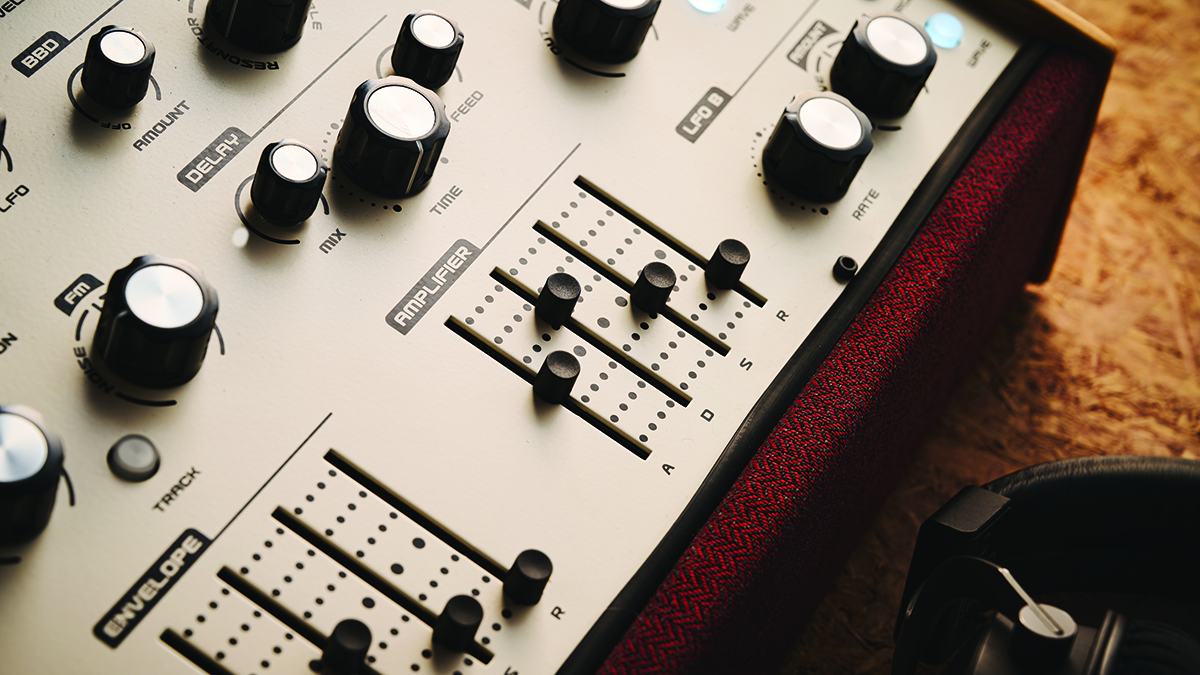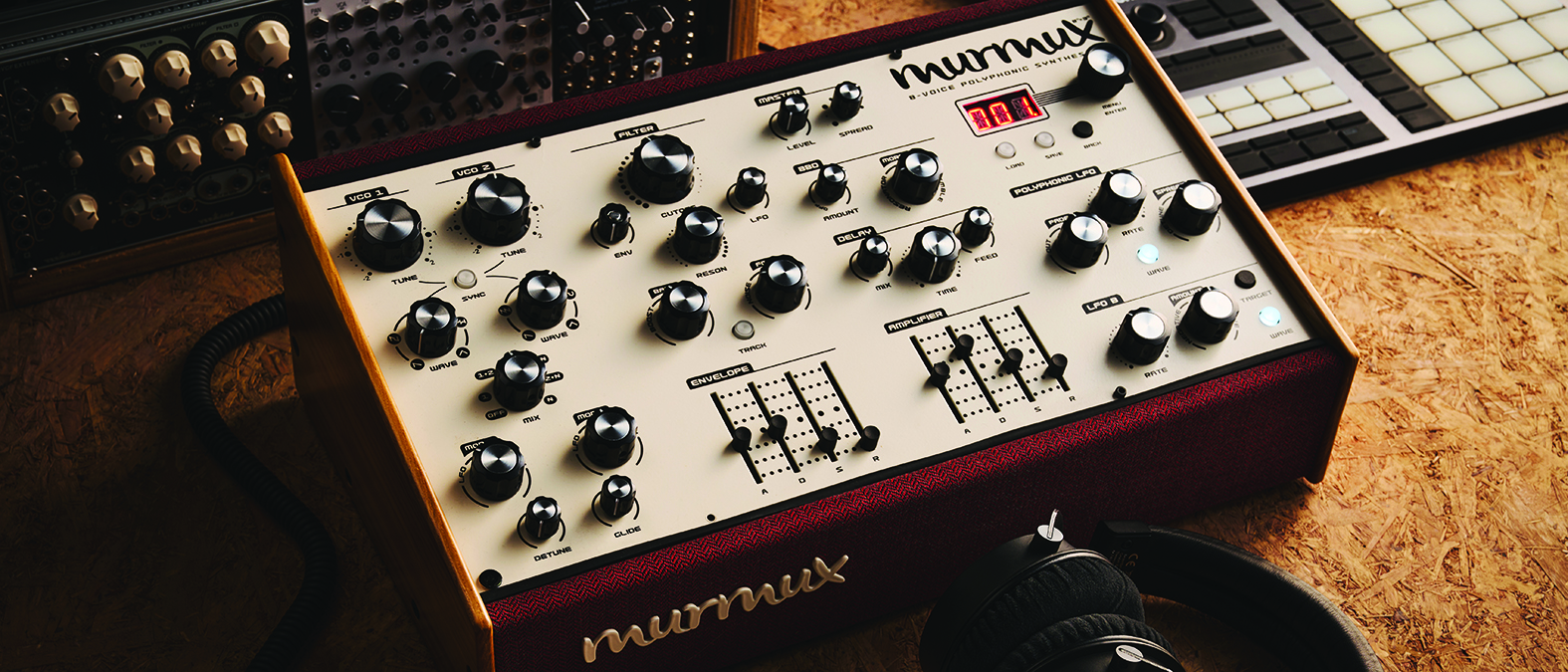MusicRadar Verdict
While it doesn’t offer anything revolutionary, Murmux’s gorgeous, characterful sound and quality design live up to its top-end price point.
Pros
- +
Gorgeous, classy analogue sound.
- +
Well laid out UI and morphable controls are a joy for hands-on programming.
- +
Solid and sturdy build with a distinctive look.
Cons
- -
Expensive, with few bells and whistles.
- -
Additional I/O options would be welcome.
- -
Filter drive hidden in a sub menu.
MusicRadar's got your back
Dreadbox Murmux Adept: What is it?
Dreadbox’s Murmux synth has come in a variety of forms over the past decade. The original was one of the Greek brand’s first instruments, and since then it's been revived in upgraded, often limited edition forms multiple times, as well as lending its core analogue components as the basis for a number of other Dreadbox products, like its Abyss polysynth. Clearly, Murmux is an instrument close to the company’s heart.
Upon plugging in and playing this latest incarnation, it’s not hard to see why. With its rich, morphable oscillators, smooth filters and analogue, BBD-powered effects, this eight-voice poly is an exceptionally classy-sounding synth. As one would hope, given a price point that puts it at the very top end of desktop synths.

The Murmux Adept edition is only available in desktop format, including neither a keyboard or sequencer, but boasting a neatly laid-out, knob-per-function interface. The instrument itself comes in a wooden enclosure with herringbone fabric covering its front and rear panels. The combined effect is to give Murmux the air of something that wouldn’t have looked out of place amidst the lace doilies and questionable taxidermy in our late grandmother’s living room. We don’t necessarily mean that as a criticism – it’s a distinctive look and undoubtedly high-quality construction – but leans heavily into the retro end of synth design.

Ins and outs
The I/O on offer is standard. A stereo pair of jacks act as a main output, along with a stereo headphone out, joined by MIDI in and out ports, plus a USB port for MIDI and firmware updates. Murmux will respond to a full range of MIDI CCs, as well as velocity, mod wheel and aftertouch, which are routable in its menu – handy for use with those morphable controls. Given the price, it’s a shame not to have a few more I/O options – expression pedal and CV control would work, given the synth’s vintage feel, and an audio in to run sounds through the great effects would have been very welcome.

Dreadbox Murmux Adept: Performance and verdict
At least at first glance, the vintage ethos appears to carry through to the overall design of Murmux. The sound engine here is a bread-and-butter subtractive affair, albeit with high quality evident throughout. Each voice begins with two VCOs, which are syncable and joined by a white noise generator.

• Oberheim OB-X8 Desktop
The module version of Oberheim’s comeback synth lands at a similar price, and equally puts timeless sound ahead of extra features.
• UDO Super 8
Looking for a more modern take on an 8-voice poly? UDO’s latest balances classy analogue with forward-thinking digital ideas.
• Analogue Solutions Fusebox X
While it’s only tri-phonic as opposed to being a full poly, AS’s synth module comes from a similarly vintage-inclined, hands-on world view.
These feed into a filter section that combines a resonant 24dB low-pass filter with a Bass control that mixes a 12dB high pass filter and a low-shelf bass boost, depending on whether it’s turned in Cut or Boost directions. Modulation is provided via two ADSR envelope generators and two LFOs – one polyphonic and routed to filter cutoff and osc pitch, the other freely assignable.
While these core elements are fairly straightforward, there are design touches throughout that give Murmux its own distinctive character as well as modernising the sound. One of the most notable features is the fact that almost all controls are continuously morphable. Each VCO, for example, can be swept from saw to triangle through various widths of pulse wave in between. The oscillator mixer, similarly, is a continuous control that blends the two oscillators and noise generator as it’s swept, left to right. The nature of these controls means that they’re great for hands-on manipulation of sounds, but also that they can be modulated, either from the internal LFO 2 or via MIDI CC.
Want all the hottest music and gear news, reviews, deals, features and more, direct to your inbox? Sign up here.
Elsewhere, Murmux’s filter is capable of audio-rate cutoff modulation, with a dial that can route this using either VCO 2 or the noise output as a source, to variable levels. Each oscillator also has a pitch modulation control, which can use the LFOs or envelopes as sources, while global detune and glide controls allow for further modulation of the overall pitch.

The highlight of Murmux’s sound engine, however, is its two stereo analogue effects. The first is a short BBD effect that can variably create ensemble, flanger and comb filter effects as you sweep its Morph control. This is joined by a stereo delay with time, feedback and mix level controls. With short time and long feedback, this can function as a nicely uncanny-sounding reverb, while modulating the time parameter with LFO B can create drifting, tape-echo-like tones.
These effects both function in stereo, and the overall sound width can be altered via a global spread control. This not only spreads the output of the effects, but introduces stereo variation between the synth voices, resulting in a brilliantly cinematic, widescreen sound.

Murmux is, mostly, a synth where what you see is what you get, to its credit. While the 399-slot preset bank comes stocked with a good crop of pre-made sounds, the chunky, spacious interface makes the process of designing sounds so simple and pleasurable, it feels like a waste not to craft each sound from scratch. There is an option menu, although this is thankfully mostly used only for ‘under-the-hood’ settings, like setting velocity and aftertouch routings and adjusting LFO sync settings. The exception is the filter drive control, which it’s disappointing not to see on the front panel, even though it only has three levels available – low, mid and high.
On paper, Murmux doesn’t look like good value; despite its eight analogue voices and modern touches, its bells-and-whistles pale in comparison to similarly priced polys from the likes of Arturia, UDO or even Sequential. Such a comparison arguably does Murmux a disservice though. This is a vintage-minded, boutique instrument for those who values quality design, hands-on simplicity and rich, nostalgic sound. A better foil is probably the module version of Oberheim’s OB-X8, which similarly trades modern flexibility for simplicity and great sound quality. Given this current run is limited to 300 units too, Murmux is likely an instrument that will hold its value in the long term too.
MusicRadar verdict: While it doesn’t offer anything revolutionary, Murmux’s gorgeous, characterful sound and quality design live up to its top-end price point.
Dreadbox Murmux Adept: Hands-on demos
Dreadbox
J S H G
SYNTH ANATOMY
Dreadbox Murmux Adept: Specifications
- KEY FEATURES: 8-voice analogue polysynth with BBD and delay effects, plus stereo spread. i/0: Stereo audio out, headphone out, MIDI in and out, USB MIDI. Limited to 300 units.
- CONTACT: Dreadbox
I'm the Managing Editor of Music Technology at MusicRadar and former Editor-in-Chief of Future Music, Computer Music and Electronic Musician. I've been messing around with music tech in various forms for over two decades. I've also spent the last 10 years forgetting how to play guitar. Find me in the chillout room at raves complaining that it's past my bedtime.



